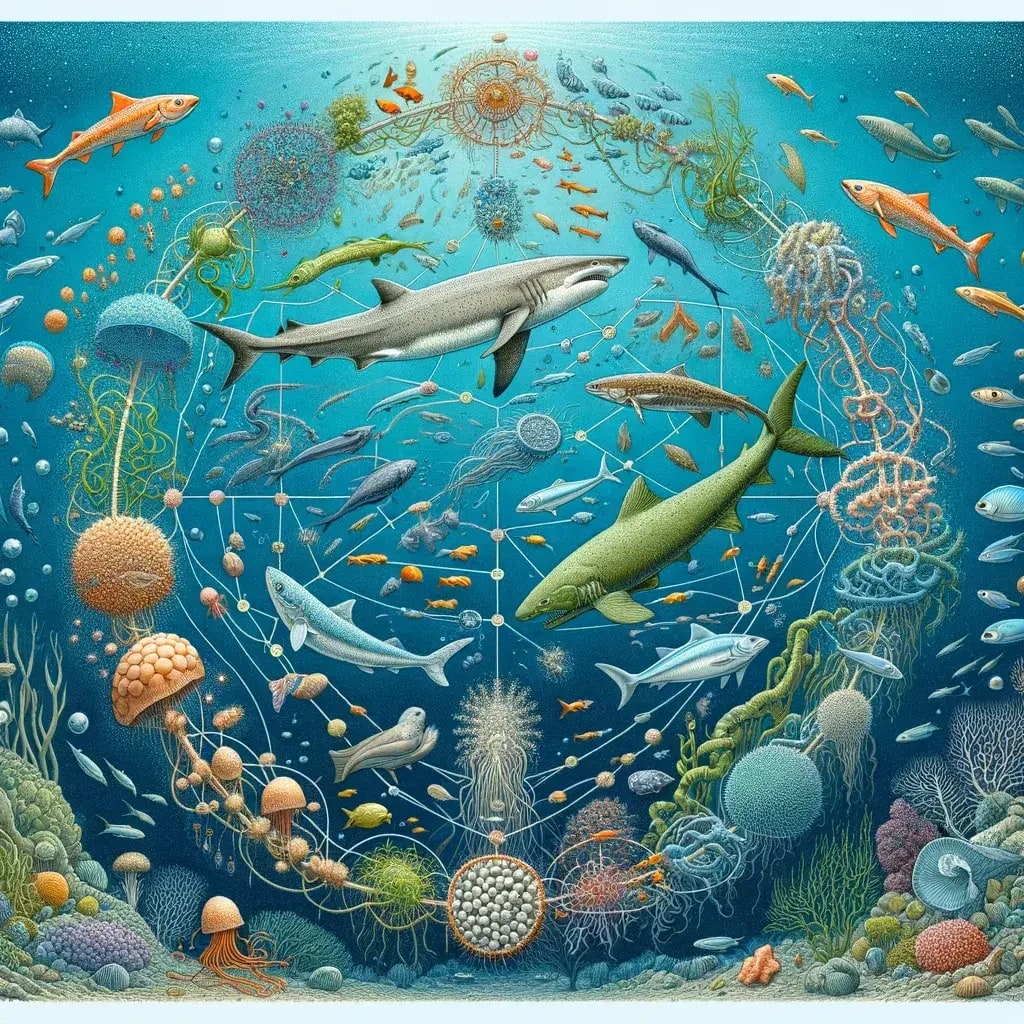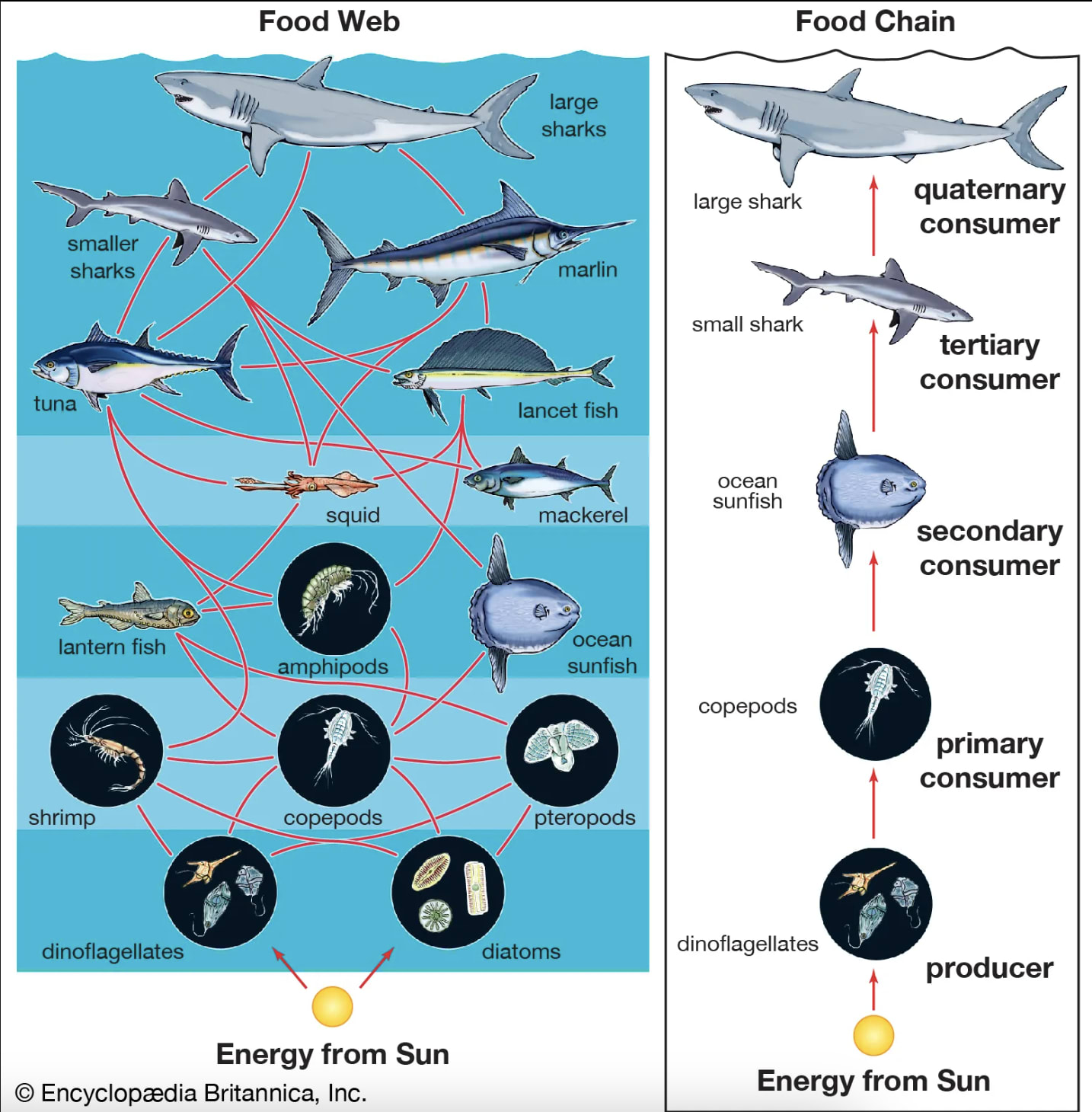Summary
The net welfare effects of fishing, changes to fishing pressure and demand for wild-caught aquatic animals on wild aquatic animals seem highly morally ambiguous, in large part because there are
- tradeoffs between species due to predation, e.g. larger (respectively smaller) populations and life expectancies for one species results in smaller (respectively larger) populations and life expectancies for their prey and competitors, and this cascades down the food chain,
- uncertainty about moral weight tradeoffs between affected species, and
- depending on the moral view, uncertainty about whether the directly and indirectly affected animals have good or bad lives on average.

Acknowledgements
Thanks to Brian Tomasik, Ren Ryba and Tori for their feedback on an earlier draft. All errors are my own.
For prior related writing that is more comprehensive and suffering-focused, see Tomasik, 2015–2017. This piece focuses on population effects, overlapping largely with Tomasik, 2015.
Population effects and welfare uncertainty
Increasing the fishing of a species will tend to decrease their population, and decreasing their fishing will tend to increase their population, all else equal. For a given species, the marginal and average effects of fishing on the number of them alive at any time are typically at least several times greater than the effects on their annual catch under standard single-species fishery models.[1] With fishing deaths making up such a small share of a life on average, even if intense (although stunning during capture may be more widely used in the future), the effects on the size of the population and resulting welfare effects could be more ethically important than the effects on the number of fishing deaths.
And then the effects on the populations could be morally ambiguous. First, it may be ambiguous whether the average individual has a good or bad life, so that reducing their population through fishing and increasing their population by reducing fishing could be morally ambiguous. Second, there are also population (and life expectancy) tradeoffs between species due to predation, with increasing the population of one species reducing the populations of its prey species.[2] Fishing reduces the populations of the directly fished species and (I’d normally guess) species up the food chain that depend on them,[3] while increasing the populations of the (unfished) prey (and competitors) of the directly fished species. But then the increased populations of the (unfished) prey (and competitors) may result in decreased populations for their prey. And so on.
For example, Peruvian anchoveta, the species most wild-caught for feed and the most wild-caught fish species by numbers of individuals and tonnage (Mood & Brooke, 2024, Supplementary material 3, Supplementary material 6, Borthwick et al., 2021), primarily eat krill and copepods (Espinoza & Bertrand, 2008, Espinoza & Bertrand, 2014), so fishing Peruvian anchoveta presumably decreases Peruvian anchoveta populations but increases krill and copepod populations.[4]
I illustrate with the effects of fishing on the fished pieces and their (unfished) prey:
| Fished animals have good lives | Fished animals have bad lives | |
| Unfished prey have good lives | Bad for fished animals Good for unfished prey | Good for both |
| Unfished prey have bad lives | Bad for both | Good for fished animals Bad for unfished prey |
Effects of fishing on fished animals and their unfished prey, in a simple model ignoring the rest of the food web. Fishing decreases the populations of the fished animal populations and increases the populations of their unfished prey, and these lives could be good or bad. Similarly, fishing increases mortality rates and reduces life expectancies in the fished species, cutting short good or bad lives, but does the opposite for their unfished prey, prolonging good or bad lives. Reducing fishing has the opposite effects.
The potential ambiguities in overall welfare effects come from the following:
- Fishing could be good for one group but bad for the other, and tradeoffs between them may be ambiguous. These are the top-left and bottom-right possibilities. Even if we were sure about the signs of the quality of life or had morally asymmetric views or person-affecting views, ambiguity with respect to tradeoffs between the two groups of animals could make the overall effects morally ambiguous.
- It’s unclear whether their lives are good or bad, so we have to weigh all of the possibilities in the table, which have opposing signs or are ambiguous themselves, but it’s unclear how to weigh them. Even if one of the two groups of animals dominated morally, it would still be ambiguous whether the effects are good or bad overall. (If we’re suffering-focused or expect that wild aquatic animals have bad lives, we would consider only the bottom-right entry, which is also morally ambiguous.)
The effects considered here can also cascade further along the food web. If the prey have larger populations, their prey should have smaller populations, and then the prey of the latter should have larger populations, and so on, although this oversimplifies the food web into a relatively linear one. Two meta-analyses confirm similar predator-prey effects and trophic cascades in marine ecosystems, Hulot et al., 2014[5] and Eger & Baum, 2020[6]. There are also other population size dependencies between species, like parasitism[7] and competition[8].

If the prey or other animals in the food web were also fished, then their fishing could be increased or decreased to compensate for changes in predation or competition-related mortality.
The magnitudes of population effects — in terms of numbers of individuals alive at a time — could be larger for animals lower in the food chain, especially copepods, because of their marine abundance and importance in marine food webs. On the other hand, I’d expect the average individual animal lower in the food chain to matter less morally, and we could perhaps effectively ignore copepods and other similarly small or smaller animal plankton, no matter their number. If small animal plankton like copepods don’t dominate the impacts, then I’d expect effects on small fish like anchovies, shrimp, krill and possibly other arthropods or gastropods to dominate the effects of fishing on wild aquatic animals in the near term. I will discuss these issues further in the next piece.
- ^
In single-species fishery models, it is assumed only one species is caught, ignoring the possibility of other species, especially their predators and prey, being caught and resulting effects. At equilibrium under the standard discrete Schaefer model (Haddon, 2023), the number caught per period is equal to the number of new individuals (recruitment) per period, after accounting for natural (or non-fishing) mortality,
Where
- is the number of individuals caught per period,
- is the number of individuals alive before capture in the period,
- (more than the share of the original individuals at the start caught over the period, because recruitment over the period),
- (or ) is the carrying capacity of the stock in numbers of individuals, i.e. the natural/unfished population size, and
- is the intrinsic rate (per period) of population increase, which reflects both fertility and natural mortality.
Then,
On the other hand,
reaches a maximum absolute value of , at with value and at with value (@, and then ). On the other hand, is 0 at , where equilibrium/sustainable catch is maximized as .
is typically around 1 or smaller for a period of 1 year (e.g. Jensen et al., 2012 and Patrick & Cope, 2014) and except with no fishing or an entirely eliminated stock, so typically and . I’d also expect to be much less than K and so |dN/dU| in most fisheries, too, with closer to its maximum sustainable (e.g. FAO, 2022, Figure 23, Ritchie & Roser, 2021–2024). However, there are disagreements over what model forms are best and hence and hence maximum sustainable yields.
Instead of numbers of individuals, biomass can be used, typically with notation B instead of , and catch and carrying capacity would be measured in biomass (e.g. tonnes) rather than number of individuals, too.
- ^
- ^
However, Hilborn et al. (2017) find that the effects of fishing forage fish on their predators are often overstated by simple trophic models, highlighting:
• Predator rate of increase is uncorrelated with forage fish abundance.
• Forage species are affected much more by environmental conditions than by fishing.
• Previous analysis of forage fish impacts on predators ignored natural variability.
• Spatial distribution of forage species may be more important than their abundance.
• Predators often take small forage fish that are unaffected by fishing.
- ^
The picture can be complicated by trophic levels not exactly being well-defined as integers or cleanly separable. Peruvian anchoveta eat krill and copepods (Espinoza & Bertrand, 2008, Espinoza & Bertrand, 2014). But then these krill themselves also eat animal plankton, including copepods — and perhaps fish eggs and/or larvae. They are mostly herbivorous according to Ramiro Riquelme-Bugueño et al., 2020, but it’s unclear based on Espinoza et al., 2017, Figure 7, given an estimated trophic levels of 2.8, greater than that for herbivores. Animals that eat the Peruvian anchoveta, whose populations decrease with fewer anchoveta available, might also eat copepods as larvae or juveniles, so reducing the population of anchoveta reduces the populations of their predators and also reduces the pressure from those predators on copepods as well.
Then some copepods are themselves also predators of other animal plankton and even the eggs and larvae of fish (Landry, 1978, Landry et al., 1985, Yen, 1987, Bundy et al., 2005, Djeghri et al., 2019). Around a third of identified copepod species are parasites of fish or invertebrates (Humes, 1994, Bernot et al., 2021).
See also Trophic level - Wikipedia.
Without assessing effect magnitudes, it’s therefore unclear whether fishing Peruvian anchoveta increases or decreases copepod populations, because fishing Peruvian anchoveta reduces the number of copepods eaten by Peruvian anchoveta (and plausibly their predators), but increases krill populations, increasing the number of copepods eaten by krill.
Still, my best guess in this case would be that fishing Peruvian anchoveta and decreasing their populations indeed increases krill and copepod populations, and the latter because the krill they eat are primarily herbivorous. This would also be consistent with Christensen et al., 2014.
- ^
Hulot et al., 2014, “a meta-analysis of 31 lake mesocosm experiments”, found planktivorous “fish presence has a positive effect on phytoplankton and a negative effect on zooplankton in the food chains” and specifically “a positive effect on highly edible algae and small herbivores, a negative effect on large herbivores and omnivorous zooplankton, and no effect on poorly edible algae”
- ^
Eger & Baum, 2020, a meta-analysis of observational and experiment studies, found “predators decreased herbivore populations between 2.1-4.76 times” and that “herbivore populations in marine reserves [without fishing] were 2.83 times lower on average compared to areas outside the reserve”.
- ^
Parasite-host relationships may also be similar to predator-prey relationships, although I’d expect smaller effects of parasites on their host populations than predators on their prey populations, all else equal, because predators by definition kill their prey. Around a third of identified copepod species are parasites of fish or invertebrates (Humes, 1994, Bernot et al., 2021), and if primarily parasitic, would presumably decrease in abundance with decreasing host abundance.
- ^
Pure competition between species would mean fishing one reduces that species’ population and increases the population of its competitors. Peruvian anchoveta and the species of krill they eat may compete over copepods, so catching Peruvian anchoveta or krill leaves more copepods for the other, supporting the other’s population. Still, fishing the krill that Peruvian anchoveta would otherwise eat could increase or decrease the food available for Peruvian anchoveta: more krill but fewer copepods to eat.
